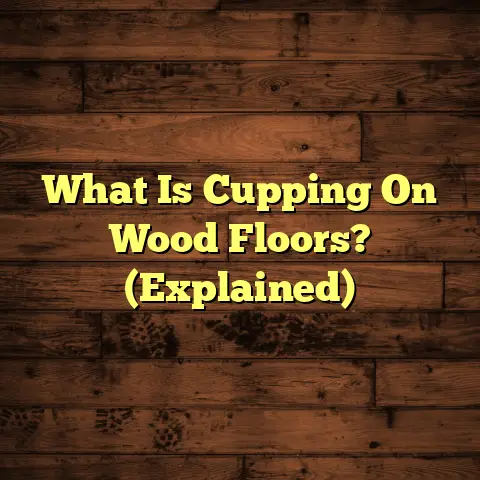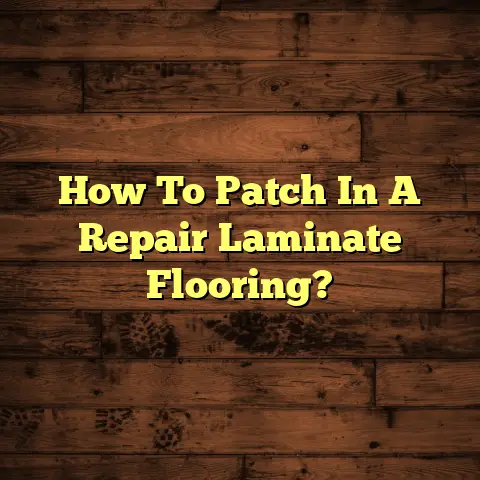Gym Floor Covers on Carpet? (1 Hidden Danger!)
I’m Mike, a flooring contractor with over 15 years of experience, and I’ve seen it all when it comes to gym flooring.
And let me tell you, there’s one issue that keeps popping up and causing headaches: gym floor covers placed directly on carpet.
I get it.
You’re trying to protect your carpet, create a more workout-friendly surface, and maybe even save a few bucks.
But trust me, that seemingly simple solution can lead to some serious problems down the road.
I want to share what I’ve learned over the years, so you can make informed decisions about your gym’s flooring.
Think of this as a friendly chat over coffee, where I spill the beans on a hidden danger lurking beneath those floor covers.
Imagine this: a bustling gym, filled with the sounds of clanking weights and pumping music.
Everyone’s in the zone, pushing their limits.
Then, BAM!
Someone trips over a loose section of carpet hidden under a floor cover, resulting in an awkward fall.
Injuries, potential lawsuits, and a tarnished reputation for your gym… it’s a nightmare scenario.
And it’s more common than you might think.
That’s why I’m here to shed light on this critical issue.
1. Understanding Gym Flooring and Its Importance
Let’s start with the basics.
Gym flooring isn’t just about aesthetics; it’s about safety, performance, and durability.
You’ve got a bunch of options to choose from:
-
Rubber: The workhorse of the gym, great for weightlifting areas due to its impact absorption and durability.
-
Foam: Softer and more forgiving, ideal for aerobics, yoga, and kids’ areas.
-
Vinyl: A versatile option that offers good durability and is easy to clean, suitable for various activities.
-
Carpet: a carpeted flooring can be great for low-impact activities such as stretching, yoga, pilates and more. It’s comfortable but not great for high intensity workouts.
Choosing the right flooring depends on the activities taking place in each area.
You wouldn’t want to do heavy deadlifts on a thin yoga mat, right?
And then there are gym floor covers.
These are temporary or semi-permanent solutions designed to protect the existing floor, add a layer of cushioning, or create a specific workout surface.
They’re often used on carpeted surfaces to transform a multi-purpose room into a temporary gym area.
2. The Popularity and Benefits of Gym Floor Covers
So, why are gym floor covers so popular?
Here’s the lowdown:
-
Cost-Effectiveness: They’re generally cheaper than replacing the entire floor.
-
Versatility: You can easily change the flooring based on the activity.
-
Protection: They shield the underlying carpet from wear and tear, spills, and heavy equipment.
-
Maintenance: Many are easy to clean and maintain.
-
Aesthetics: They can improve the look of the space and create a more inviting workout environment.
You’ll find different types of gym floor covers, each with its own perks:
-
Rolls: Large sheets of material that cover a wide area, great for quick installation.
-
Tiles: Individual squares that can be easily replaced if damaged.
-
Interlocking Pieces: Easy to assemble and disassemble, perfect for temporary setups.
3. The Hidden Danger: Carpet Underneath Gym Floor Covers
Okay, here’s where things get serious.
While gym floor covers seem like a simple solution, placing them directly on carpet can create a hidden danger zone.
The biggest problem?
Moisture gets trapped.
Think about it: sweat, spills, and even humidity can seep through the floor cover and get trapped in the carpet fibers.
This creates a breeding ground for mold, mildew, and bacteria.
According to the EPA, mold growth can occur on surfaces with excessive moisture, and it can start within 24 to 48 hours. EPA Mold Website
And that’s not all.
The trapped moisture can also lead to:
-
Deterioration of the carpet: The carpet fibers can break down, leading to a mushy, uneven surface.
-
Unpleasant odors: Mold and mildew produce a musty smell that can make your gym stink.
-
Health problems: Mold spores can trigger allergies, asthma, and other respiratory issues.
But here’s the kicker: you might not even realize there’s a problem until it’s too late.
The floor cover hides the damage, allowing it to worsen over time.
4. Real-Life Examples and Case Studies
I’ve seen the consequences of this firsthand.
I remember one gym owner who called me in after noticing a persistent musty smell in their aerobics room.
They had installed interlocking foam tiles over the existing carpet a few years prior.
When we pulled up the tiles, we were greeted by a horrifying sight: the carpet was covered in mold and mildew.
The damage was so extensive that the entire carpet had to be removed and replaced.
And it wasn’t cheap!
I’ve also heard stories from other flooring specialists about gyms facing similar issues, leading to costly repairs, health concerns, and even temporary closures.
One of my colleagues told me about a gym that faced a lawsuit after a member developed a severe respiratory infection due to mold exposure.
These are real risks, folks.
And they’re not worth taking.
5. Analyzing the Impact of Hidden Dangers on Gym Operations
So, how can these hidden dangers affect your gym operations?
Let’s break it down:
-
Increased Maintenance Costs: You’ll need to spend more money on cleaning, repairs, and potential replacements.
-
Loss of Memberships: No one wants to work out in a smelly, unhealthy environment.
-
Damage to Reputation: Word of mouth travels fast, and negative reviews can hurt your business.
-
Legal Ramifications: As I mentioned earlier, mold exposure can lead to lawsuits and financial liabilities.
-
Impact on Gym Culture: A safe and clean environment is essential for creating a positive gym culture.
Ignoring these hidden dangers can have long-term repercussions on your gym’s success.
It’s like ignoring a small leak in your roof; it might seem insignificant at first, but it can eventually lead to major structural damage.
6. Conclusion: Raising Awareness About the Risks
Alright, let’s wrap things up.
I hope I’ve shed some light on the hidden dangers of using gym floor covers on carpet.
It’s a seemingly simple solution that can lead to some serious problems down the road.
Moisture retention, mold growth, and deterioration of the carpet are just a few of the risks involved.
As a gym owner or operator, it’s your responsibility to create a safe and healthy environment for your members.
That means being aware of the potential flooring issues and taking steps to prevent them.
So, what can you do?
-
Consider alternative flooring options: If you’re planning a new gym or renovating an existing one, explore options like rubber flooring, vinyl, or specialized gym carpet.
-
If you must use floor covers, take precautions: Ensure proper ventilation, clean the covers regularly, and inspect the carpet underneath for signs of moisture or damage.
-
Consult with a flooring professional: Get expert advice on the best flooring solutions for your specific needs.
Remember, investing in the right flooring is an investment in your gym’s success.
It can improve safety, enhance performance, and create a positive experience for your members.
Don’t let a seemingly simple solution turn into a costly and dangerous problem.
Stay informed, stay proactive, and keep your gym a safe and healthy place to sweat!
I hope this article has been helpful.
If you have any questions or want to share your own experiences, feel free to leave a comment below.
And remember, I’m always here to help you navigate the world of gym flooring.





